
Thoughts On Ideas
This week’s lectures was by the course leader, Susanna Edwards. It explored ways of thinking and how ideas are generated.
Design is still a relatively new process and as it became more of a ‘want’ rather than a ‘need’ designers started to look at how successful design solutions were arrived at. In the early 20th century Bauhaus (above) revolutionised many companies with their approach to design. The below diagram depicts their teaching processes.
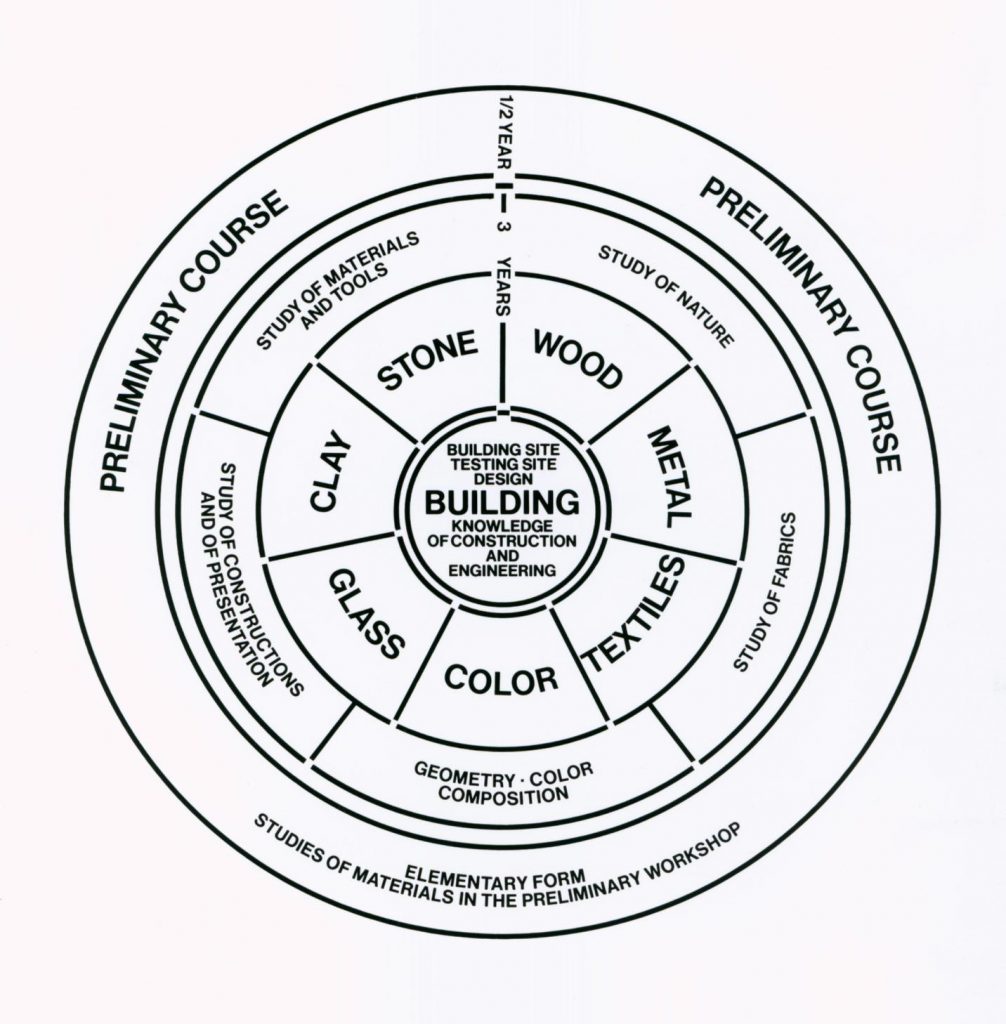
Education at the Bauhaus school was extremely diverse with subjects including carpentry, mural painting and even parties and stage performances. I personally think that this approach to design provides a unique holistic approach. Inspiration and experience can come from anywhere when it comes to design and by studying a vast plethora of subjects you can become a more well rounded designer.
I also think this links with the idea that immersion in a subject matter, for a client for example, allows you to experience their own identity and provide a better informed solution.
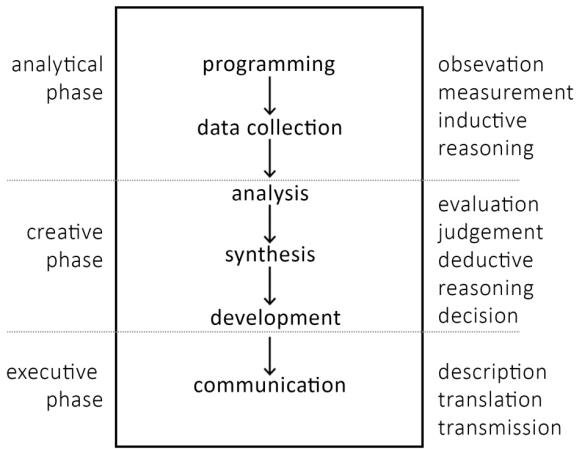
Bruce Archer published the above model of the design process in 1963 and broke it down into six key stages. These stages were then further broken down into three subcategories of observation, evaluation and description and transmission.
“An architect preparing plans for a house is clearly designing. So is a typographer preparing a layout for a page of print. But a sculptor shaping a figure is not. What is the difference? A key element in the act of designing is the formulation of a prescription or model for a finished work in advance of its embodiment. When a sculptor produces a cartoon for his proposed work, only then can he be said to be designing it.” Bruce Archer, Systematic Method for Designers (1963)
Archer’s method was a mere 229 step(!) methodology of how designers work. In the quote above he tries to draw a distinct line between artists, sculptures and graphic designers. I feel that the lines between all of these can get a bit blurred, so to try and create a method for one can be a bit prescriptive. Designers can be artists, right?
I also feel this process is a bit linear in its creation and in reality, as designers, its important to revisit certain stages to achieve the best possible outcome. It’s also important to remember that we are not always masters of our own destinies and clients will sometime (often!) want something different to what is presented to them. This process, when explained to a client, does help them see how a conclusion is reached.
Design Process of Today

The double diamond diagram was developed through in-house research at the Design Council in 2005 as a simple graphical way of describing the design process.
It is divided into four distinct phases, Discover, Define, Develop and Deliver and shows how two instances of looking wider, at the bigger picture, before honing in on specifics to refine a solution to the problem.
I do wonder if this method lives in an ideal world as well. By that, I mean, what happens if the client isn’t, or even through meticulous research you miss an important aspect of the clients identity? Do you just carry on to a sub par solution or do you start again? I know what I would do!

Edward de Bono’s ‘Six Thinking Hats’ technique really resonated with me. Often, as a lone designer, the design process can be quite overwhelming. By focusing on these six individual areas of thought you are able to pull together a thoroughly examined problem which will lead to a comprehensive solution.
The Two Systems of Thinking

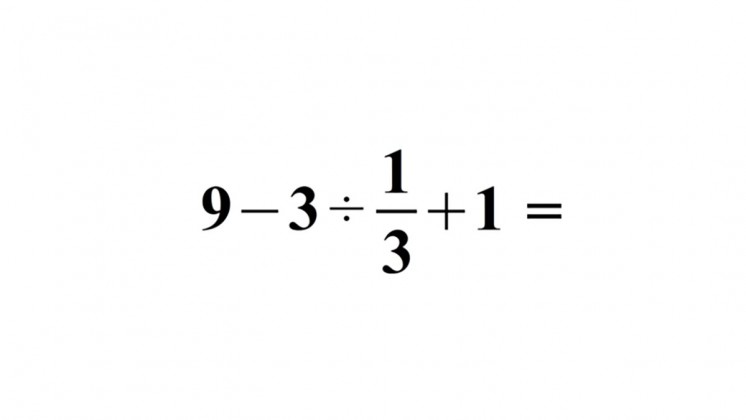
- System 1 operates automatically and quickly, with little or no effort and no sense of voluntary control.
- System 2 allocates attention to the effortful mental activities that demand it, including complex computations. The operations of System 2 are often associated with the subjective experience of agency, choice and concentration.
I love the idea that the brain thinks in one of two ways, sometimes independently and sometimes together. So for example, the angry man – you know he is angry just by looking at his face. This is an instant assumption. The longer you look at him the more you notice – he is pointing at you, he is saying something, he is red in the face and scrunching up his nose. Life is full of these instant and longer discoveries and it this is just as important to design as well. Some of the best brands in the world create an instant connection with their viewer. However, there are legions of followers devoted to certain brands because of their story, heritage and culture – Something you wont know about instantly.
Ian McGilchrist extends this train of thought through the separation of the right and left hemispheres of the brain. He poses that the left hemisphere, “allows us to create space from the immediacy of experience.” or in other words moving from system 1 to system 2.
The right hemisphere provides a system 2 approach, ” sees things in context, relational, makes associations. It understands implicit meaning, metaphor, body language, emotional expression. It understands an embodied world that sits within a world that is concrete. It understands categories.”
For imagination you need both hemispheres. For reason you need both hemispheres.
Ultimately, the brain is a complex and unique personal computer which is capable of a digesting a vast amount of information in a short period of time. I don’t think we are truly aware of its capabilities and believe that each and every one of us process information at different rates and in different ways.
Workshop Challenge
- Explore and find an example of a way of thinking. This could be from the area of arts, design, philosophy or science.
- Choose a thinker or a process and summarise in a black line drawing.
- Explore models of thinking – what sorts of theories and process models exist to help us generate ideas?
- Document your whole process and reflect upon it in your blog.
- Upload your final black line drawing to the ideas wall and a link to your blog showing process and reflection.
So, the Double Diamond Method was created in 2005. That’s 15 years ago and I wanted to look at how other ideas could be incorporated or developed to provide a more holistic approach which resonated with me personally.
The first thing I wanted to improve on was the linear pathway which was laid out in the diagram. I found this image below and thought it more accurately depicted the madness of design thinking.
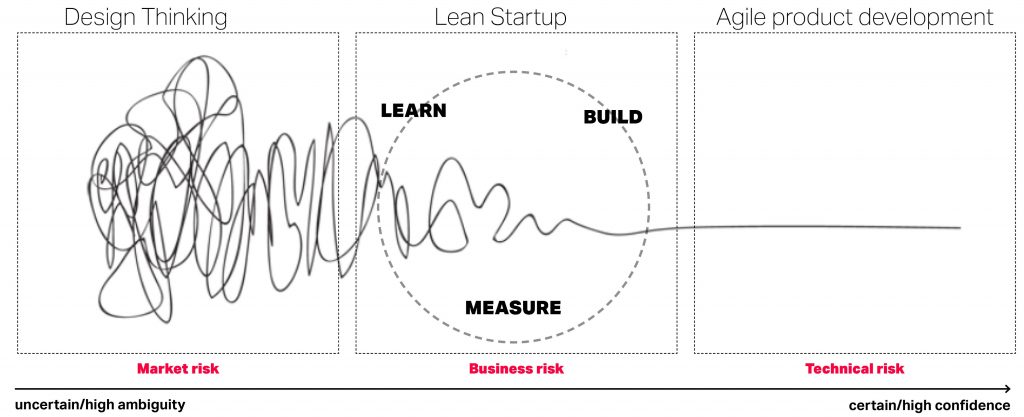
Secondly, I wanted my diagram to show the cyclical nature of design and that sometimes we can go round and round until we have found a suitable solution. I also think that each time we take on a design process we get better at it but i don’t know if I can symbolise experience within my desing.
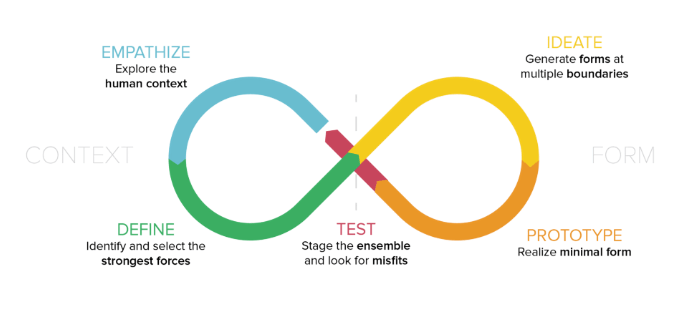
My Idea – The Triple Diamond



The Ideas Wall
Personal Reflection
Before this week started I am not sure I really thought about how I formulated ideas or the thinking behind it. It really is a tough thing to nail down. Designers / Artists, whatever you want to call us, are quite an unruly bunch. We don’t like to follow a rule book or follow a path that is laid out for us. This is evident in the differences in the methods explored above.
I think Bauhaus was trying to explain to the world that as creatives we don’t just focus on one area and try to become experts. We are eclectic and enjoy creativeness in whatever form it comes in. I also feel there is another element which is forgotten in the Bauhaus diagram and that is personal experience or identity. We are product of our parents, surroundings and experiences. how we react to something, or choose to explore a subject is somewhat already established before we engage with that subject.
I personally think that Bruce Archer tried to contain the design process too much and while it was a good step forward in helping provide a systematic approach to design the variables in today’s society are too vast to contain.
As I said above, the Double Diamond approach really did resonate with me. I believe that the immersion stage is so important when looking at a brief and vital in providing a successful outcome. By exaggerating certain aspects of the diamond you get, in my opinion, a more accurate depiction of the design process.
Edward de Bono’s six thinking hats will be used in my process going forward to allow me to delve deeper into the subject I am exploring. This idea of taking a step back before jumping in allows us to empathise with our clients to fully understand their own identities, where they have come from and what makes them unique.
I am really happy with how the workshop challenge came out this week. I hope it does make sense to others as I feel it addresses some shortcomings of the original Double Diamond Method and takes into account a wider context.
Even if the Triple Diamond Method cannot be applied to a wider Graphic Designer cohort, it is perfect visual representation of how my brain works in creating for clients.
References
‘RSA Animate – The Divided Brain – RSA.’ n.d. [online]. Available at: https://www.thersa.org/discover/videos/rsa-animate/2011/10/rsa-animate—the-divided-brain.
‘The School of Life – On Exercising the Mind.’ n.d. [online]. Available at: https://www.theschooloflife.com/thebookoflife/exercise-for-the-mind/.
BOWELL, Tracy and Gary KEMP. 2015. Critical Thinking: A Concise Guide. Fourth edition. London: Routledge. Available at: http://www.vlebooks.com/vleweb/product/openreader?id=Falmouth&isbn=9781315772035.
KAHNEMAN, Daniel. 2012. Thinking, Fast and Slow. London: Penguin.
GOLDSTEIN, E. Bruce. 2015. Cognitive Psychology: Connecting Mind, Research, and Everyday Experience. 4th edition ; student edition. Stamford, CT: Cengage Learning. Available at: http://www.vlebooks.com/vleweb/product/openreader?id=Falmouth&isbn=9781473713345.
Bauhaus. Building. Image. Available at: https://www.domusweb.it/en/movements/bauhaus.html [Accessed 19/01/21]
Bauhaus Process Diagram. Available at: https://trydesignlab.com/blog/bauhaus-school-five-lessons-for-todays-designers/ [Accessed 19/01/21]
Bruce Archer Design Process. Available at: https://rebeccaclulow.co.uk/2019/03/06/thoughts-on-ideas/ [Accessed on 19/01/21
Double Diamond Method. Available at https://medium.com/this-is-hcd/beyond-the-double-diamond-47e2271b4e1f [Accessed 19/01/21]
Six Hats Method. Available at: https://www.onedaydesignchallenge.net/en/journal/six-thinking-hats-technique [Accessed on 19/01/21]
UX Strategy. Available at: https://www.meetup.com/UXSCHICAGO/ [Accessed 19/01/21]
Design Thinking. Infographic. Available at: https://www.maqe.com/insight/the-design-thinking-process-how-does-it-work/ [Accessed 19/01/21]

Leave a Reply